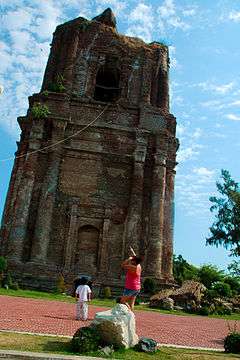Bacarra Church
| Bacarra Church | |
|---|---|
|
San Andres Apostol Parish Church Iglesia Parroquial de San Andrés Apóstol | |
|
The leaning bell tower of Bacarra | |
.svg.png) Bacarra Church Location within the Philippines | |
| 18°15′02″N 120°36′42″E / 18.250495°N 120.611788°ECoordinates: 18°15′02″N 120°36′42″E / 18.250495°N 120.611788°E | |
| Location | M. Castro Street, Brgy. Sta. Rita, Bacarra, Ilocos Norte |
| Country | Philippines |
| Denomination | Roman Catholic |
| History | |
| Dedication | Saint Andrew the Apostle |
| Architecture | |
| Status | Parish church |
| Functional status | Active |
| Heritage designation | National Cultural Treasure |
| Designated | 1973 |
| Style | Church building |
| Completed | 1593[1] |
| Administration | |
| Archdiocese | Nueva Segovia |
| Diocese | Laoag |
| Province | Nueva Segovia |
| Clergy | |
| Archbishop | Marlo Mendoza Peralta |
| Bishop(s) | Renato P. Mayugba |
Bacarra Church is a Roman Catholic church located in the municipality of Bacarra, Ilocos Norte, Philippines under the jurisdiction of the Roman Catholic Diocese of Laoag. The church was founded by the Augustinians, who dedicated it to St. Andrew.
The church was declared a National Historical Landmark by the National Historical Commission of the Philippines, and a National Cultural Treasure by the National Museum of the Philippines. It is known for its centuries-old, domeless, leaning bell tower.
History
The Augustinians founded the town of Bacarra on September 18, 1590 and began their missionary activity on land owned by a chieftain the Spaniards named Castillo and a certain Andres Hermosa.[2][3] Baccara was established as a mission center for the Apayaos.[2] The Augustinian mission was run by two priests serving a population of 4,000.[3] The church and an adjoining convent were established in 1593[1] on the site where an Igorot named Bacsalandoc, first settler of the town and chieftain, had erected his hut.[3] The church site is now located in the center of town.[4]
The town became a visita of Laoag in 1603 and an independent parish in 1614.[3] In 1782 a new church on the site was inaugurated by the Augustinians.[1][4]
In 1973 President Ferdinand Marcos declared the church a National Cultural Treasure through Presidential Decree No. 260.[5]
Features
Bell tower
The Bacarra church is famous for its centuries-old, domeless or "beheaded" belfry known as Torre ti Bacarra.[3][6] The structure stands three stories and 50 metres (160 ft) high.[7] The original bell tower, which is detached from the main church building and made of coral bricks, was erected in 1828.[8][9] However, periodic earthquakes from 1931 to 1971 caused the dome to start leaning.[8][9] The entire dome was toppled by a 7.8-magnitude temblor on August 17, 1983.[1] Restoration of the church was completed in 1984 at a cost of ₱3 million.[1]
The tower is also known as the "Acrobatic Bell Tower of Bacarra".[10]
Church museum
The church museum, known as Museo de Bacarra, is housed in the former church convent. The two-story restored convent, which dates to the Spanish colonial era, features religious artifacts from archival photos and documents and church relics and cultural artifacts mostly contributed by the people of Bacarra.[8] A mysterious underground staircase leading to three tunnels – believed to be connected to the Bacarra river, the church tower, and the altar – was uncovered at the back of the old convent.[8]
Notes
- 1 2 3 4 5 "Tourist Attractions in Bacarra". bacarra.gov.ph. 2010. Retrieved 26 October 2014.
- 1 2 Galende 2007, p. 30
- 1 2 3 4 5 "Bacarra". Official Website of Ilocos Norte. Local Government Unit of Ilocos Norte. Retrieved September 11, 2014.
- 1 2 "Bacarra Church and Convent". Municipality of Bacarra. Retrieved 26 October 2014.
- ↑ "Presidential Decree No. 260 August 1, 1973". The Lawphil Project. Arellano Law Foundation. Retrieved September 5, 2014.
- ↑ Arzadon, Christina (November 20, 2012). "Bacarra Museum: New Oasis of Religious, Cultural Artifacts, Mysterious Underground Garden Near 'Beheaded' Belfry Ruins". Ilocos Sentinel. Retrieved October 27, 2014.
- ↑ Coseteng 1972, p. 73.
- 1 2 3 4 Arzadon, Christina (November 21, 2012). "Museum hopes to put Ilocos town on tourism map". Philippine Daily Inquirer. Retrieved September 11, 2014.
- 1 2 Legarda, Benita (1960). "Colonial Churches of Ilocos". Philippine Studies. Ateneo de Manila University. 8 (1): 121–158.
- ↑ Esguerra 2012, p. 228
Bibliography
- Coseteng, Alice M. L. (1972). Spanish Churches in the Philippines. UNESCO National Commission of the Philippines.
- Galende, Pedro (2007). Philippine Church Façades. Manila: San Agustin Museum. ISBN 9789710724338.
- Esguerra, George (2012). The Borough of Licab. Trafford Publishing. ISBN 9781426955990.
